Centrifugal compressors are described along with all the required information, such as their core definition, components, working, applications, pros, and cons. Let’s explore Centrifugal compressors!
What are Centrifugal Compressors?
Let’s try to understand the basics as well as the definition of centrifugal compressors.
Centrifugal Compressors Basics
Centrifugal compressors as we know that there are different kinds of compressors available for other purposes. One of them is centrifugal compressors that are also called radial compressors.
- Also, compressors are mainly used for pressure processes, and when it comes to using something massive or powerful, centrifugal compressors come into play.
- With the proper knowledge and insights about this compressor, one can use it accordingly for different purposes.
- Centrifugal compressors hold a prominent place amongst all compressors due to their robust operation.
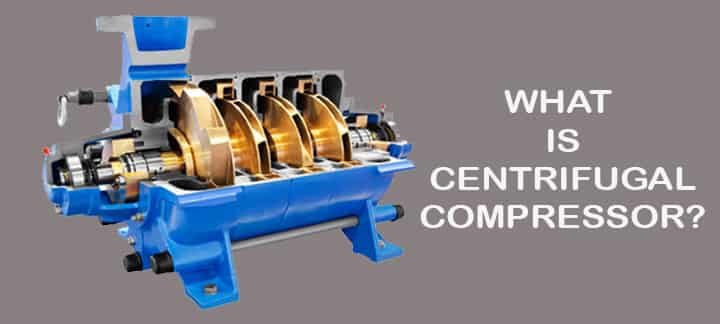
We are also adding a section that contrasts between centrifugal and the most powerful compressor, i.e., reciprocating compressors. Let’s start with the core definition:
Centrifugal Compressor Definition
As we know that centrifugal compressors are also known as radial and turbo compressors that specifically come from the roto-dynamic kind of compressors. The desired pressure hike occurs due to the regular conversion of angular momentum imposed on the air or gas or refrigerant vapor with the help of a high-speed impeller.
- Centrifugal compressors are used in those places where there is a need for steady and continuous flow.
- This makes centrifugal compressors a machine that has minimal noise and vibration.
In other words, we can say that centrifugal compressors are the compressors that get a pressure rise by adding kinetic energy to a continuous flow of fluid.
- This process effectively needs a rotor or impeller.
- This kinetic energy gradually helps in the increase in static pressure or potential energy by keeping a slow flow through the diffuse.
- The rise in force in the diffuser and impeller remains at the same level in most of the scenarios.
Before getting into the working procedure, it is essential to acquaint yourself with the components or parts of compressors. Let’s delve into the different components of centrifugal compressors.
Parts of Centrifugal Compressors
An ideal centrifugal compressor has four components:
- Casing
- Inlet
- Impeller
- Rotor assembly
- Diaphragm
- Bearing
- Balance drum
- Sealing
- Diffuser
- Collector
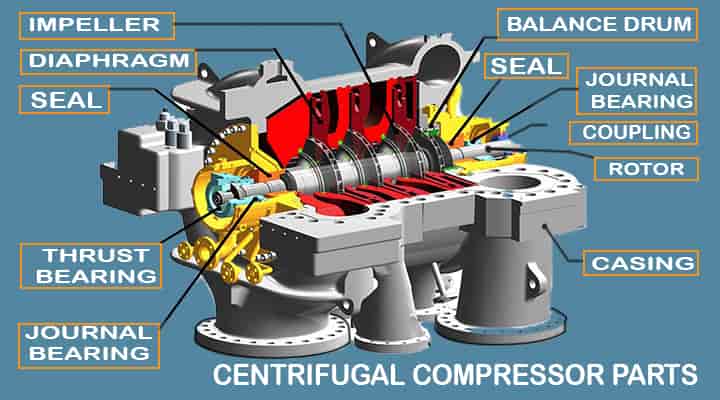
Casing
The Centrifugal compressor has an outer envelope that is rated for maximum discharge without any leaks.
- Pressure rating is based on the discharge pressure or project requirements.
- It may be a vertical or horizontal split casing.
- Normally, piping is connected at the bottom side to avert any kinds of disturbance during maintenance.
Inlet
The inlet is the foremost component of a centrifugal compressor that is just a pipe. As the name depicts, it helps the insertion of gas.
- It is equipped with a valve, airfoils, and an inlet guide vane.
- It is among the parts that have useful features for temperature and pressure processes.
- The different subsidiary components of the inlet provide massive support in the control of centrifugal compressors.
Inlet Guide Vane (IGV) shall be as follows,
- It helps to streamline air.
- It is placed in front of the impeller.
- It can be fixed or variable.
Impeller
One of the prominent parts of a centrifugal compressor is the centrifugal impeller which is equipped with a rotating set of blades that regularly increases the energy of the gas.
- This is quite similar to the axial compressor, through the gas can effectively get on the higher energy and velocities levels.
- This process happens as the impeller’s rotation movement increases the radius.
- In the recently developed centrifugal compressors, the gas exit speed can be the same as the sound speed.
The design of impellers is of different varieties such as visible blades or open blades, shrouded or covered, with or without splitters. Modern impellers use back sweep in the blade shape, which helps attain maximum efficiency. We can get into the deep of the turbine and pump Euler’s equation to understand the impeller’s performance.
Rotor Assembly
The rotor is one of the main parts through which energy is transmitted from the driver to the impeller. It consists of the follows,
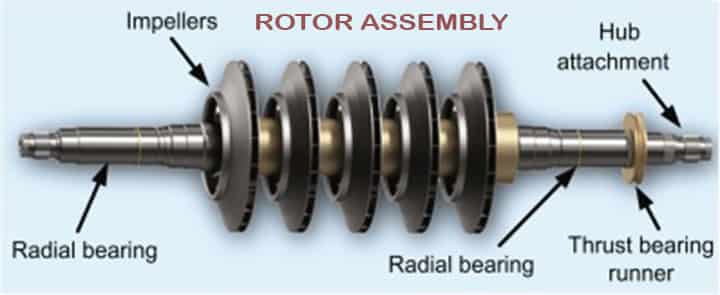
- Driveshaft
- Driven shaft
- Bearings (thrust, journal, etc.)
- Hub
- Thrust Collars
- Balanced drum
- Sleeves
- Spacer rings
- Sealing (Labrinth & oil film end)
Diaphragm
In case of two or multistage centrifugal compressors, a stationary part named a diaphragm is introduced inside the casing to direct the fluid from one impeller to another impeller.
Bearings
Bearings are a must to reduce the losses. These are thrust bearing, journal bearing etc.
- Thrust bearing restricts the axial thrust or motion of the shaft.
- Journal bearing helps to rest the shaft. The shaft is supported by the journal bearings at the end.
Balance Drum
- The impeller of the compressor generates axial as well as radial thrust.
- To balance these thrusts, a balance drum is used.
Sealing
The shaft comes out from the casing to connect the drive shaft, hence, there will a gap and possibility of leakage of air from that gap.
- Proper sealing is provided at both ends of the shaft to restrict the leakage.
- It also restricts the ingression of atmospheric air.
Diffuser
There are some parts of the centrifugal compressor that are essential for regular operation. The diffuser is among those parts that are responsible for converting the kinetic energy of the gas into pressure.
- This process takes place gradually, and it is quite slow.
- Diffusers can be of different structures, such as vaned or vaneless or an alternating structure.
- If you want high efficiency, then vaned diffusers are the foremost ones as they come up in different ranges from 1 to 4.
- There are some hybrid versions of diffusers that consist of the channel, pipe diffusers, and wedges.
- The diffuser performance significantly depends upon Bernoulli’s fluid principle.
Collector
Some parts of the centrifugal compressors come in different shapes and forms. It is also known as plenum when the diffuser discharges the gas.
- The sole functioning of a diffuser is to accumulate the flow from the diffuser discharge.
- It delivers the flow to the downstream pipe.
- The collector contains valves and different instrumentation that controls the compressor.
After getting an idea about the centrifugal compressor now, it is time to grab insights about the core working and how does it work?
How Does Centrifugal Compressor Works? Working Philosophy
After getting a broad idea about the centrifugal compressor components, it is now an excellent time to shift our attention towards the core operation of the centrifugal compressor. The compressor, whether it may be handled gas or air, the working philosophy is the same.
Pointwise Working Process
Here we are providing a brief pointwise step that can quickly help you to understand the working of centrifugal compressors:
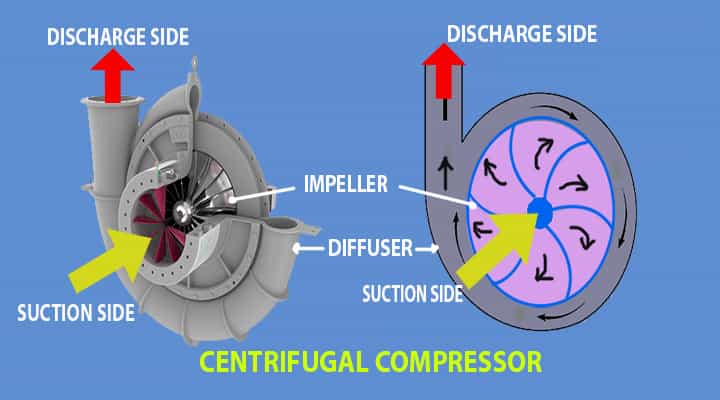
- Firstly, the air is drawn into the center of the impeller with a radial blade.
- It is then pushed to the center by the centrifugal force as the impellers keep on rotating.
- The radial movement of the gas or air raises the pressure and generates kinetic energy.
- Here the kinetic energy is converted into pressure when the air passes volute and diffuser.
How do centrifugal compressors work?
Brief description of how do centrifugal compressors work?
Step#1 Air suction: Firstly, air suction and the flow pass through the inlet. Let’s see the process,
- Centrifugal compressor is connected to drivers like motor or VFD or Steam turbine or gas turbine, etc. to rotate the rotor of the compressor.
- A Centrifugal impeller is mounted on the compressor shaft.
- The compressor shaft starts to rotate at the same speed as the motor shaft.
- The high speed of the shaft, as well as the impeller, creates a vacuum at the center of the impeller which is known as the impeller eye.
- Due to this vacuum, air draws into the compressor.
Check out a NICE VIDEO from FS Elliot,
Step#2 Application of centrifugal force: Secondly, the flow here remains axial and uniform and in a swirling motion as the flow goes through the impeller.
- Due to the rotation, the impeller is responsible for providing a centrifugal force on the fluid that helps the flow spin faster in a rotational axis.
- As per the turbine and pump equation, the energy input to the fluid or liquid is proportional to the liquid flow’s local spin velocity multiplied by the impeller’s tangential velocity.
Step#3 Reduction of velocity: In most cases, as we mentioned above, the flow speed is equal to the speed of sound, which gradually passes through a stationary compressor, which makes it decelerate the speed.
- The increasing flow area where energy transformation gets into account.
- In case the user wants to convert the flow in the rear direction, then the impeller or combustor can easily be reduced by channelizing the flow with the help of stationary running valves.
- A gradual increase in channel or diffuser area will reduce the velocity.
Step#4 Rise in Pressure energy: These four steps are the core operating cycle of the centrifugal compressors.
- Here, the reduction of pressure means velocity head or kinetic energy is reduced.
- In a nutshell, Bernoulli’s principle comes into play that causes the pressure energy to rise for the reduction of the velocity head or kinetic energy.
Special Note
Every step helps in raising the overall pressure of the compressor unit. Some steps are arranged in a pattern, such as a series, to achieve the desired pressure.
- This is specifically known as the multistage application of compressors widely used in the oil and gas and process industries.
- In contrast to these, single-stage applications are used in wastewater treatment plants where low pressure is needed.
- In recent times the centrifugal compressors re-equipped with ultra-high-speed electric motors. These are specifically used for driving the impellers.
If these types of equipment are used, we can expect a centrifugal compressor without oil- lubrication system and gearbox, which makes it quite efficient.
Types of Centrifugal Compressors
When it comes to different kinds of centrifugal compressors, then there are two basic criteria by which we can categorize them. These are,
- Based on nos. of stage
- Based on types of casing
Though all kinds of compressors work on the same principle, there are some of the core differences that we will discuss gradually. Here we are providing a brief idea of both types of centrifugal compressors, based on stages –
- Single-stage centrifugal compressor
- Multistage centrifugal compressor
Single-stage compressor
The single-stage compressors are equipped with a single impeller. This single impeller is used for the dynamic changes in the air or gases.
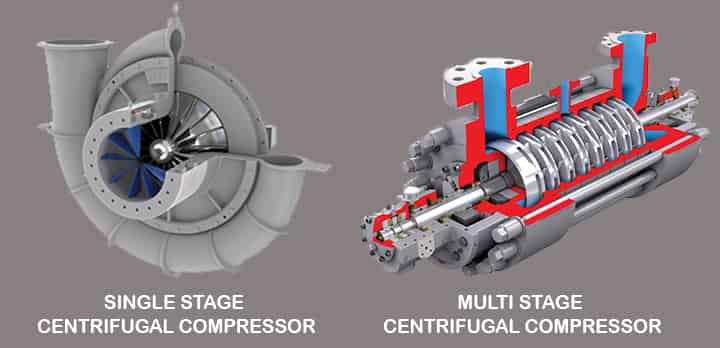
- This can compress to the work compression ratio from 3 to 1 either for vacuum duty or pressure.
- These types of compressors are equipped with an overhung impeller or effective beam design.
- The impeller is attached at the non-driving corner of the shaft.
- One of the best-in-class advantages of this in comparison with other types is its high efficiency and the oil-free and surge less gas output.
Multistage compressor
This kind of compressor is equipped with multiple impellers. Specifically, it can contain 1-10 impellers.
- These impellers can be arranged in various structures and flow paths.
- These configurations are dependent upon the flow path as well as the number of impellers.
- These compressors are arranged or designed in different designs such as compound, double-flow configurations, straight through, and others.
- In this, the impellers are located between the radial bearings; this is the core reason these are often having beam-type designs.
Let’s see a brief idea of both types of centrifugal compressors, based on types of casing –
- Horizontal split centrifugal compressor
- Vertical split centrifugal compressor
Horizontally Split Casings
As the name suggests, horizontal split casing compressors open up by splitting the casing horizontally.
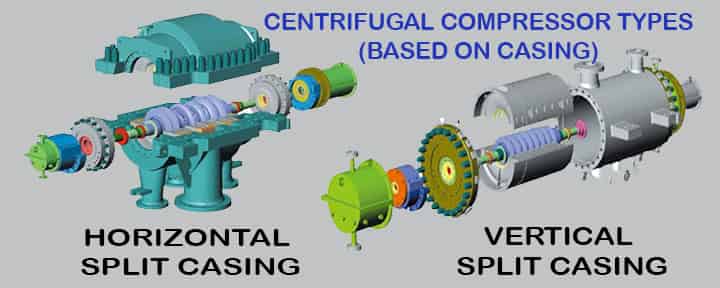
- Casing is constructed into two parts.
- These two parts are divided with a horizontal centerline.
- In case of any maintenance, top portion is removed.
- This casing is considered below 60 bars.
Vertically Split Casing
As the name suggests, vertical split casing compressors open up by splitting the casing vertically.
- The casing is constructed like a cylinder and this cylinder is closed by two end covers.
- Due to the cylindrical shape, it is also called as battel type.
- It is used normally for multistage compressors.
- Considered for high-pressure applications up to 690 bar.
Applications of Centrifugal Compressors
The applications of centrifugal compressors are vivid as it provides massive benefits. Here we are providing an elaborative idea about the various kinds of usage.
Used in auxiliary power units and gas turbines
As we know that gas turbines are used in almost all massive pieces of machinery. We can deduce that modern gas turbine operation is based upon the Brayton cycle.
- Centrifugal compressors are used explicitly for providing compression.
- The different types of machinery that contain gas turbines as their significant parts are microturbines, auxiliary power units, and aircraft engines.
- When it comes to a specified quality check, the civil or military body prescribed the standards while selecting the centrifugal compressors.
- These are specifically chosen to attain maximum durability as well as safety.
- While using centrifugal compressors in these pieces of machinery, we have to consider some of the most prominent aspects in which the structure of impellers is the foremost.
- In gas turbines, we use impellers that are manufactured of titanium alloy forgings.
Used in superchargers, turbochargers, and engines
Numerous fields use centrifugal compressors in sync with reciprocating internal combustion engines.
- These are also known as turbochargers as they are driven with the help of turbo-superchargers and engine exhaust gas.
- There are numerous methods through which we can analyze the performance of turbocharger centrifugal compressors.
Transfer of natural gas
One of the core usages of a centrifugal compressor is in the transfer of natural gas. This use can be of one or multistage.
- Massive turbines drive these.
- This specific use of centrifugal compressors is in the plants of natural gas in which it is being transferred from the production site to the consumer.
- The most significant factor that supports this is the proper design and the testing and automation of the pipelines.
- Pipelines are the prominent aspect that helps us in getting the maximum out of this machine.
Used in refrigerating, HVAC, and Air conditioning
As we know, centrifugal compressors can provide numerous vapor compression cycles and can be used in different kinds of refrigerants in the HVAC system.
- These are effectively used in numerous configurations and sizes.
- It also helps in providing compression in the water chiller cycles.
Purification plants
These compressors are also used for intercooling. These are designed, tested, and analyzed as per the set regulations to achieve maximum efficiency.
- Though this sector is somehow on the brink of advancement, it is being used widely in recent times.
- This is one of the applications that provide a compelling advantage in attaining sustainable aspects.
Apart from the above, the centrifugal compressors are applied in the below areas,
- Oil and gas field as well as Refineries
- Medical and pharma industries
- Fertilizer industries
- Pesticide industries
- Explosive manufacturing industries
- Power plants
- Mining and metallurgy
- Steel plants, etc.
Pros and Cons of Using a Centrifugal Compressor
Pros of Centrifugal Compressor
After getting all the relevant information, it’s time to delve into the different benefits of this efficient machine. Here we are providing a brief advantage set of centrifugal compressors.
- Centrifugal compressors are lightweight and easy to design compared to other kinds of compressors.
- These are suitable for various cooling units as it helps in providing continuous compressed air supply. This is among the widest use of a centrifugal compressor.
- It doesn’t have the lubrication system that makes it oils-free.
- The operation of centrifugal compressors doesn’t include numerous rubbing parts. Due to this, it has the minimum chance to get wear and tear often.
- As compared to positive displacement compressors, it has a high flow rate, which makes it quite efficient.
- Centrifugal compressors are relatively energy efficient that helps in acquiring maximum benefits.
- The reliability factor of centrifugal compressors is on the upside, making them less prone to regular maintenance.
- As compared to axial flow compressors, it has a higher pressure ratio, which effectively helps in all the pressure processes.
- Centrifugal compressors don’t need any foundation at the time of installation.
Cons of Centrifugal Compressor
- As compared with axial flow compressors, centrifugal compressors are equipped with a large frontal area for airflow rate.
- These are not preferred for high compression as they can only be used for limited pressure.
- The sensitivity towards the change in gas composition is high in this kind of compressor.
- As these are operated at high speed, the user needs to install them on a vibration mounting so that ill effects of vibration can surge.
- Centrifugal compressors are often prone to choking, stalling, and surging, which reduces the efficiency of the same.
Centrifugal Compressor Manufacturers
There are so many manufacturers available for centrifugal compressor, few of them are as follows,
- Atlas Copco
- Mitsubishi Heavy Industries
- KKK
- Ingersoll Rand
- Comp Air
- Man
- Hitachi, etc.
Conclusion
In contrast to the other kinds of compressors, centrifugal compressors provide an effective and productive operation. The advantages of centrifugal compressors keep them preferable for a long time. It can be used for different purposes, whether it is industrial or small. With the useful insights of all the relevant information about this, we can deduce that this is among the best ones. Here we have dealt with almost all the information associated with this compressor, though there are numerous sets of others that can be discussed elaboratively.
Our YouTube
Refer our YouTube Videos


